Mahoning Avenue Pioneer Cemetery
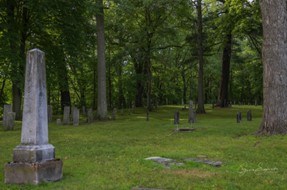
Sheltered underneath a canopy of giant maple trees and carpeted with lush green grass, the Mahoning Avenue Pioneer Cemetery is one of the few places in Warren that looks just the same today as it would’ve two hundred years ago. While walking through, the hustle and bustle of nearby Mahoning Avenue dissipate into a melodic forest song, punctuated by the notes of robins' tweets and squirrel chirps no matter what the season. Situated on 1.4 acres of land formerly belonging to Henry Lane Jr. who arrived at Warren from Washington County, Pennsylvania in the spring of 1800 with his family. Lane Jr. donated the use of this tract to the then-budding village for use as a public burial ground––the first in the city.
Minus a few toppled markers, The Old Mahoning Cemetery looks just the same as it would have 200 year ago.
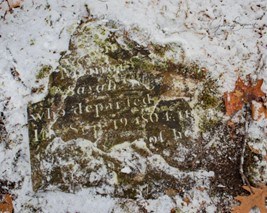
In September 1804, what is now referred to as the Mahoning Avenue Pioneer Cemetery saw its first burial when Sarah “Sally” (Fitch) Adgate, the first female resident of neighboring Howland Township passed away at the age of 40. Arriving in 1799 from Norwich, Connecticut along with her husband, John Hart Adgate, the family settled on 1600 acres of land purchased for a dollar a piece from Connecticut Land Company proprietor Joseph Howland. Being the closest established public burial ground, a choice was made to take her body there for interment, thus initiating this land's use as a cemetery for the next 94 years. With the last burial taking place in 1897, long after Warren’s first settlers arrived, it is in this cemetery that many of the old pioneers take their earthly repose at. In order to easily find the graves featured in this presentation, markers are listed in order of appearance as one walks through the cemetery, starting at the front gate, as well as photographs for easy identification.
The toppled headstone of Sarah Adgate, dated 1804, the first burial in this cemetery.
DISCLAIMER: In order to preserve the headstones on this tour for the generations to come, please refrain from making grave rubbings or any other physical contact with headstones, including touching, leaning, or resting. Not only can these actions damage the stones, but destabilize them as well. As with any cemetery, be respectful to those who rest here and conduct yourself in an appropriate manner. Photography is welcomed, and encouraged: “take nothing but photos, leave nothing but footprints.”
John Stark Edwards: A Man Who Left His Mark
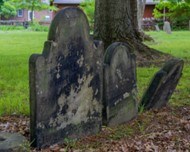
To say the Edwards family left their mark on American history is quite an understatement. Born at New Haven, Connecticut on August 23rd, 1777, and named for his father’s friend, Gen. John Edwards, who just a week before the boy’s birth on August 16th, defeated the British at the Battle of Bennington, Vermont, John Stark Edwards was from a long line of prestigious individuals. His father, Pierpont, had been a member of the Connecticut delegation that ratified the Constitution in 1789 and uncle to Aaron Burr, Alexander Hamilton’s vice president and later rival who shot and killed him in an 1804 duel. His grandfather, Jonathan Edwards was a “fire and brimstone” Congregationalist preacher best known for his 1741 sermon “Sinners At The Hands Of An Angry God.” Educated at Princeton College, where his grandfather, the famed theologian, was president at the time of his death in 1758, John Stark graduated in 1796 and furthered his education at the prestigious Litchfield Law School in Litchfield, Connecticut. Admitted to the bar in 1799 at New Haven, Edwards was soon called away when his father, one of the largest shareholders in the Connecticut Land Company, requested that he inspect his landholdings for him. In the spring of that year, John Stark departed Connecticut and headed west to Township Number 7, 5th Range on the Western Reserve, or what is now called Mesopotamia in Trumbull County where, upon arrival, he erected a crude log cabin––the first in the township. Despite roughing out a living in thwilderness at the time, due to his background in legal studies; on July 25th, 1800, with the formation of Trumbull County and the appointment of Warren as the county seat, John Stark was appointed to the position of the county’s first recorder by territorial governor Arthur St. Clair. As one of the first lawyers to settle in the Western Reserve, that August, Edwards was an attorney at the first legal trial in Trumbull County; defending wandering trader James McMahon for the killing of an Indian, Capt. George at Salt Springs following a brief confrontation. Naturally called to Warren from Mesopotamia for business, a tedious journey of twenty miles through the wilderness, in 1804, Edwards relocated to the county seat where he would reside for the remainder of his life.
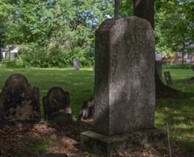
Upon a trip back east in early 1807, wedding bells toiled for John Stark when in Springfield, Vermont he married Lousia Maria Morris, a native of that town on Feburary, 28th. Returning to Warren that spring with his new bride, he soon set to work constructing a home for her at the corner of South and Vine Streets. Originally a three room affair, it was expanded in 1809 to accommodate the growing Stark family. Later expanded to its current form in the 1830s and then again during the 1870s, it was dedicated as the home of the Trumbull County Historical Society in 1938 and moved to its present location on Monroe Street in 1986. In March, 1811, Edwards enlisted in the Second Regiment, Third brigade, Fourth Division of the Ohio Militia as a colonel. Upon the humiliating defeat of General Hull at Detroit in August, 1812 which prompted invasion fears amongst the population of Northern Ohio, he marched to Cleveland with his men. Two months later in October, Edwards would become the first member of Congress to hail from the Western Reserve, appointed as a representative of the Sixth District. Unfortunately though, he would never live to take his seat, as in early 1813, he left Warren with a party of men to inspect his fathers’ landholdings on Cunninghams’ Island (Kelly’s Island) in Lake Erie. Making it to Lower Sandusky in Huron County, a thaw appeared to be coming on, and the men thought it best to turn back. In doing so, on January 29th Edwards took ill after getting wet, languished for five days and then died on February 5th at the age of 35 years. Brought back to Warren, he was interred at the Old Mahoning Cemetery beneath a simple brownstone marker. A year later, his wife remarried and relocated to Youngstown with their only surviving son, William.
Sometime during the late 1800s, a marble monument was placed in front of the Edwards grave bearing the inscriptions of the original markers. Ironically, the older monuments are more readable than the new ones.
Mary Bosworth: Smiling As The Morning Sun She Rose
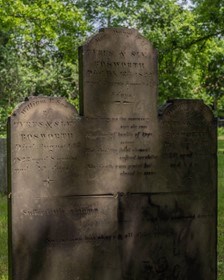
Early on the morning of February 13th, 1822, Cyrus Bosworth got up as he always did to start a fire in the parlor hearth. A 31-year old former native of Roxbury, Suffolk County, Massachusetts; he had come to Warren around 1811 and in 1817, he purchased one fourth of an acre on the northside of Courthouse Square and erected the National Hotel––a predecessor of today’s Park Hotel. While attending to his hospitable duties that brisk February morning, his family began to arise and young Mary, only three years old, leaped out of bed and made her way to the hearth intending to warm herself by the fire. Standing beside the open flame alone, wearing nothing but a cotton night dress, an errant ember flew onto her clothes and in an instant; set the poor girl afire. Hearing his daughters’ screams, Cyrus ran into the room and sprang upon her, ripping her half burnt clothes off her body––but it was too late, the poor girl was mortally injured.
Standing over the graves of the Bosworth children is a unique, three paneled brownstone monument; the middle (tallest) of which is reserved for Mary who died in 1823 when her dress caught fire due to a leaping ember.
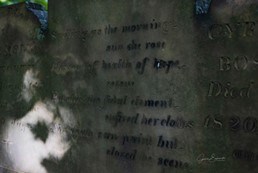 Sparing no details, her obituary in the Western Reserve Chronicle, dated February 16th, 1822 run under the byline of “SHOCKING CASUALTY” says by the time her father reached her, “it was not until she was so dreadfully burnt as to render all medical aid unavailing.” Going on to describe how she lingered in pain, the article states that “the little agonies of the suffer, for three hours, were terrible, when a sudden cessation of pain and commencement of a restless stupor demonstrated the fatal power of the fire in destroying the vital principle.” Soon, she faded away from her injuries, as “her extremetries grew cold” and “within sixteen hours” from the incident, “she was a corpse.” Taken to the burying ground on Mahoning Avenue, she was buried next to her infant brother, William R. who had died in 1820 at the tender age of 5 months and 7 days old. In 1823, another child was added to the same plot when William R, named in honor of his deceased brother, died at the age of 8 months and 29 days. Following the departure of the Bosworth children from this earthly realm, a unique three paneled sandstone marker was placed at the head of their graves commemorating the young lives cut short.
Sparing no details, her obituary in the Western Reserve Chronicle, dated February 16th, 1822 run under the byline of “SHOCKING CASUALTY” says by the time her father reached her, “it was not until she was so dreadfully burnt as to render all medical aid unavailing.” Going on to describe how she lingered in pain, the article states that “the little agonies of the suffer, for three hours, were terrible, when a sudden cessation of pain and commencement of a restless stupor demonstrated the fatal power of the fire in destroying the vital principle.” Soon, she faded away from her injuries, as “her extremetries grew cold” and “within sixteen hours” from the incident, “she was a corpse.” Taken to the burying ground on Mahoning Avenue, she was buried next to her infant brother, William R. who had died in 1820 at the tender age of 5 months and 7 days old. In 1823, another child was added to the same plot when William R, named in honor of his deceased brother, died at the age of 8 months and 29 days. Following the departure of the Bosworth children from this earthly realm, a unique three paneled sandstone marker was placed at the head of their graves commemorating the young lives cut short.
Beneath Mary’s inscription is the following verses,
which gives readers a clue on to how the poor girl met her fate:
“Smiling as the morning– un she rose
Blossom of health of hope serene
enfired her clothes Nor death can paint but closed the scene”
Ezra Rawdon: Kill’d By A Kick From A Horse
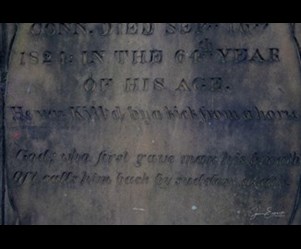
A native of Tolland, Connecticut, Ezra Rawdon was born on March 11th, 1762 as the second out of seven children to Thomas and Lydia (Bosworth) Rawdon. Little is known of his early life, however, at the age of 18 in 1780, he served in Capt. Samuel Chapman’s 22nd Regiment of the Connecticut Militia alongside 32 other local men, some from the adjoining towns of Somers and Stafford. Married to Sarah Larthrop on November 11th, 1783, this union bore the couple three children––Jeduthan, Horace, and Lois.
Below the main inscription is where Ezra Rawdon’s untimely fate is revealed with the blunt phrasing of “He was Kill’d by a kick from a horse.” A set of verses, reflecting on the unforeseen nature of his death, follows: God; who first gave man his breath/oft calls him back by sudden death”
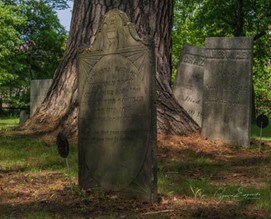
In about 1815, Ezra, now 55 years old, relocated to Northeast Ohio along with his family and four brothers. The brothers, Thomas, Daniel, Erastus and Samuel, went to Windsor in Ashtabula County, while Ezra and his family went to Warren. It would be here that on September 16th, 1824 at 64 years old, his death would be “occasioned by the kick of a horse.” Buried beneath a sandstone marker graced by a willow and urn, along with elliptical fans radiating from the top corners; the epitaph upon his grave makes note of his untimely death caused by an equine’s punt with the phrase “he was kill’d by a kick from a horse,” along with the following quote referencing the brevity of life: “God who first gave him breath afterwards oft calls him back by sudden death.”
Ezra Rawdon’s grave is topped by a dark sandstone marker featuring an oval, picture frame like insert for the epitaph, the first half of which gives nothing more than some basic information on the deceased:
“Capt. Ezra Rawdon Formerly from
Conn. Died Sept 16th 1824: in the 64th year of his age”
Calvin Austin: Masonic Pioneer
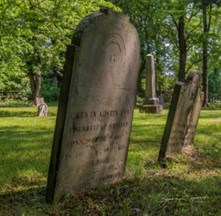
Born at Suffield, Connecticut in 1762, Calvin Austin was from a family of pioneer settlers, both within his lifetime and before. His cousin Moses, who operated various lead mines in Missouri, was the first American to obtain a land grant from the Spanish crown to establish an Anglo-American colony in modern-day Texas. Passing away before settlement commenced, it was his son Stephen who led the colony’s first 300 settlers to the southeastern portion of the state and is the namesake of Austin, the capital city. A few generations back, the great, great grandfather of all three of the men, Capt. Anthony Austin had been one of 62 proprietors and grantees from Rowley, Massachusetts to stake a claim along the Connecticut River establishing the community of Suffield in 1674.
While leaning slightly forward, the magnificent headstone of Calvin Austin is still in good shape with a readable inscription:
“Calvin Austin Esq. Formerly of Suffield Conn. Died Oct. 2nd 1819 in the 57th year of his age”
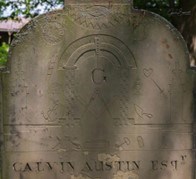
Apparently, the urge to relocate elsewhere and resettle wasn’t lost on Calvin, as in 1800 following his first wife’s death, he came to Warren, likely since he had land with the Connecticut Land Company in nearby Austintown Township. Upon the creation of Trumbull County on July 25th of that year, along with 16 other men, he was appointed as one of the first justices of the peace within Trumbull County by the first court of law led by territorial governor Arthur St. Clair. Along with the clerical duties enshrined with such a position, Calvin was also a wedding officiant. On November 7th, 1800, he conducted the first marriage ceremony in Deerfield Township at what is now Portage County between John Campbell and Sarah Ely
For all works cited used to build this article please click here.
Perhaps the most ornate headstone in the Old Mahoning Cemetery, the top portion, or lunette, of Calvin Austin’s headstone is richly decorated with symbols pertaining to the Masonic tradition. Among those noticeably included are the All Seeing Eye, Sun and Moon (with faces), and the most iconic of all, the letter ‘G” along with a square and compass.


